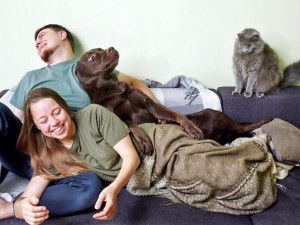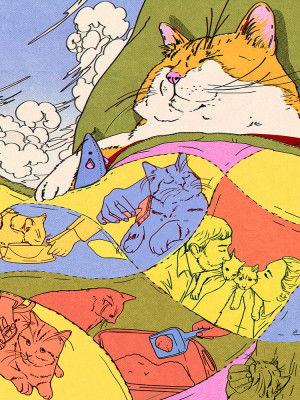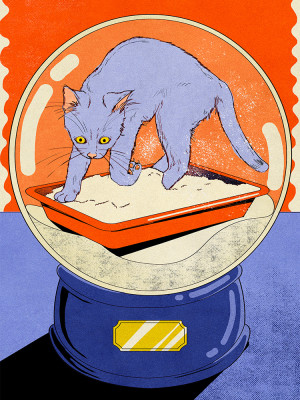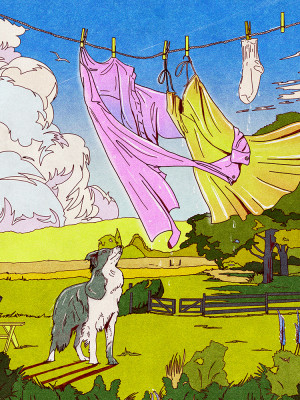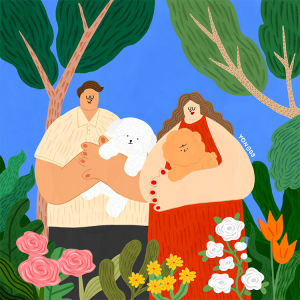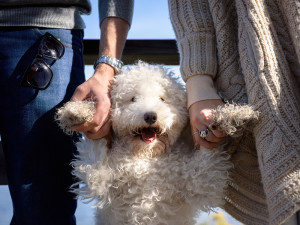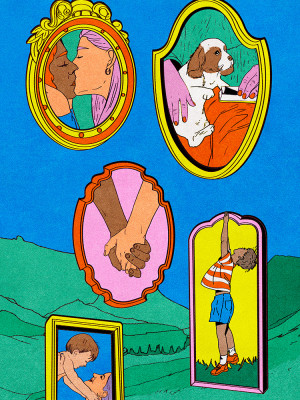
What Does Your Love Language Say About You as a Pet Parent?
We all give and receive love in our own way, pets included.
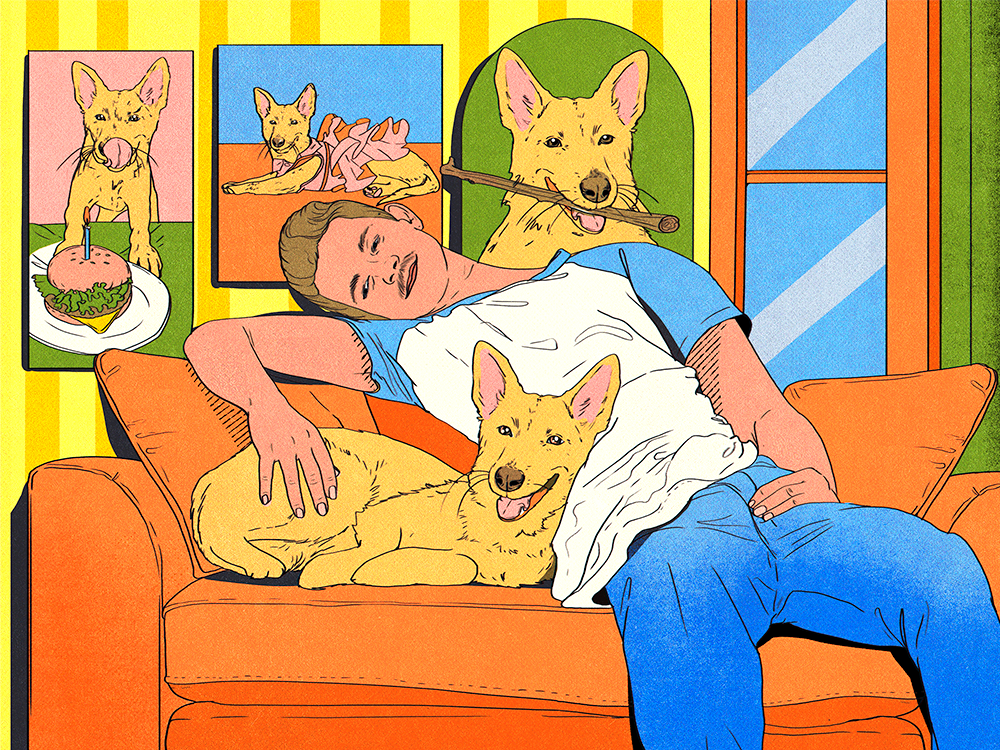
share article
Heavy Pettingopens in a new tab is a weekly column full of relationship advice for pet parents—so you and your boo don’t end up fighting like cats and dogs over the cat and dog.
If you’ve never been asked what your love language is, I simply don’t believe you! The concept has become so ubiquitous it’s basically like asking someone their astrological sign. Originally coined by Gary Chapman, a Southern Baptist pastor, he asserts in his 1992 book The 5 Love Languagesopens in a new tab that every human gives and would like to receive one of these love languages: words of affirmation, quality time, physical affection, acts of services, and gifts.
Meanwhile, every dog — according to me — has probably a dozen love languages, the list of which includes: street snacks on the walk, gentle ear pets, enthusiastic butt scratches, getting to bark at the doorbell with no admonition, an extra heaping scoop of food, permission to jump onto the bed, good weather, a long leash for park zoomies, very illegal scraps from the dinner plate, no baths, and sleeping in the sunshine on the stoop.
Are those very specific to the dogs I’ve loved? Maybe! But Mitchell Stern, a dog trainer with Yes Dog Trainersopens in a new tab, says that he’s “been using the concept of discovering a dog’s love language for as long as I can remember.”
The complexities of the love languages
The concept of love language for humans is notably fraught. Professor Emily Impettopens in a new tab, who has a miniature Dachshund named Cheerio and teaches psychology at the University of Toronto Mississauga, worked on a study published earlier this yearopens in a new tab that refuted Chapman’s limited claims.
This was a long time coming: In remarkably large print, The 5 Love Languages is doggedly simplistic, hopelessly heterosexual, and fairly problematic for human relationshipsopens in a new tab. Impett, whose job it is to treat ideas like this with scientific rigor, and her collaborators reviewed the existing empirical research on the love languages to assess whether academic research supports its key claims or assumptions.
It does not. But what the popularity — and its application to dog relationships — tells us is that people are starved for frameworks to understand relationship dynamics. We humans are nothing if not fantastic at building on a problematic concept for our own fun and amusement.
How the love languages translate to dogs
Brian Swopeopens in a new tab, a licensed marriage and family therapist from Philadelphia, says that this reapplication to pets just emphasizes the limits of the original love language structure. “I think the expansion of the love languages is just how pop culture takes in ideas and expands and remixes it,” Swope says. “Silliness definitely has a place in relationships, but this also speaks to the weakness of the love languages as a tried and true and perfected model of showing love in a relationship.”
Stern has actually developed his own love languages framework for dogs, which matches up pretty neatly with the original. In his method of dog training, there are five reinforcers, in no particular order: food, touch, eye contact, voice (praise), and play. “It’s our job as trainers to figure out a pup’s love language to offer them their greatest rewards to reinforce behaviors,” he says. The goal, he adds, is “to figure out the dog’s preferential order.”
Impett says Cheerio’s “favorite love language to give is definitely physical affection” Cheerio curls up on her lap (in the shape of her namesake cereal), and hides under a blanket for pets. “And while I think Cheerio loves this way of me expressing my love for her, if I had to pick a love language for her (and likely for lots of other dogs), it would definitely be treats.”
Below are five other exemplary dog parents on their favorite love language to distribute — and their guesses about their dogs’ favorite love language to receive.
Giving gifts
Human’s name: Layla
Dog’s name: Peggy
Human’s preferred love language to give: Buying adorable outfits for Peggy
Dog’s preferred love language to receive: Probably the absence of people walking past our apartment door (aka some peace and quiet)
Layla says: “I honestly think that I have to deal with the most amount of temptation for dog items because I’ve got a tiny baby girl Chihuahua mix and so everything to buy for her is so tiny and so unbelievably cute. Those tiny tennis balls!? And they come in pink!? I mean, we have to have them. She has more Halloween costumes than I do. But she absolutely deserves it, and she loves the attention.”
A behaviorist’s POV
“Some want a lot of attention, others prefer to be on the periphery,” says Jennifer Abramsopens in a new tab, an animal behaviorist. “Since we don’t share a spoken language and can't just ask our pets how they prefer to be loved, it’s extra important to be aware of what forms they appreciate and what they don’t.”
Words of affirmation
Human’s name: Ellie
Dog’s name: Jumper
Human’s preferred love language to give: Words of affirmation
Dog’s preferred love language to receive: A visit with her dog boyfriend who lives a few blocks away
Ellie says: “When I adopted Jumper, she was named Charlize — the adoption organization was doing one of those themed-name batches and I believe the theme was “leading ladies of Hollywood.” And Jumper is a leading lady of my heart ... She’s the very best snuggle bug, and I tell her that every day. Does she know what I’m saying? Well, I’m sure she doesn’t! But when I say nice things to her, she just wags at me with her whole body, so I think she does like getting compliments.”
A trainer’s POV
As Stern points out, probably wise for all relationships, the joy is actually learning the love language of the people we love. “I also came to learn and apply to dog training that we get to serve the love language of the recipient,” he says. “Not get ours served via ego.”
Acts of service
Human’s name: Sarah
Dog’s name: Mia
Human’s preferred love language to give: Acts of service
Dog’s preferred love language to receive: Acts of service (specifically a game of tireless fetch)
Sarah says: “Mia is a Lab mix and guess what, the vestiges of her breed remain in the form of an absolutely relentless need to retrieve things. I think this dog would pass out from a calorie deficit if I kept playing fetch. I have to say, fetch is not my passion, and Mia doesn’t know this because that would be cruel to let on that I’m only in it for her benefit. I am supportive of Mia — that’s my role in this world.
A trainer’s POV
“My perspective on acts of service for dogs is to take them where they like to go and to where they like to be, like the beach, car ride,” Stern says. “Take them on a long walk, allowing them to stop every few feet to sniff a blade of grassopens in a new tab for several minutes. Acts of service are being patient and giving selflessly to our pets.”
Physical touch
Human’s name: Katy
Dog’s name: Pepita
Dog’s preferred love language to give: Constant snuggles
Human’s preferred love language to receive: Constant snuggles
Katy says: “Every day when I come home from work, I flop onto the carpet and snuggle with Pepita before I even take my coat off. We’ve had an impossible time keeping her off the bedopens in a new tab, because she just doesn’t understand why we can’t be snuggling at all times. And every time she meets someone new, she convinces them that they’re soulmates because they are a new person with new energy to scratch her belly.”
Quality time
Human’s name: Maggie (that’s me!)
Dog’s name: Finn
Human’s preferred love language to give: Quality time
Dog’s preferred love language to receive: Peanut-butter bacon sliders (with quartered Hawaiian buns, made yearly on Finn’s birthday).
My love-language story: I wish that my love language was snuggles, but my dog Finn is not a snuggler. However, he is my coworker. I work on the couch, and every day, Finn positions himself with one exact inch of space between the edge of my legs and his back, and he spends the whole day sitting next to me. The months that I regularly used BeReal, my friend analyzed my content as “Finn napping in my direction.”
Wherever we go, he follows us around, to monitor. When I shut the door to shower, he’ll often bang it open with his paw. And we should have no boundaries — he’s right. Why ever shut a door to your best friend?
The takeaway
Crucially, there isn’t only one mode of dominant affection for dogs or people. Impett and her colleagues developed a tweak for The 5 Love Languages. They recommend an analogy of a balanced diet. Creatures need variety — they need all components. “There are also going to be times in our lives when we need certain nutrients more than others,” she says. “Mostly, it’s the application of which one is needed in a moment — but not to sacrifice others.”
References:

Maggie Lange
Maggie Lange is a writer, editor, and columnist. Her work has been featured in New York Magazine, Vice, Guernica, GQ, Rolling Stone, Pitchfork, Elle, and Bon Appetit. She lives in Philadelphia with her favorite brindle boy, Finn.
Related articles
![an illustration of a cat inside a snowglobe]() opens in a new tab
opens in a new tabWhat Happens When the Love of Your Life Is Allergic to the Other Love of Your Life?
You don’t have to choose between your S.O. and your dog or cat — but here’s what may need to happen.
![a white dog stares up at a pink dress and yellow dress waving outside in the wind on a clothing line]() opens in a new tab
opens in a new tabWhen Is It Too Early to Get a Dog Together?
You’re in love, but is it irresponsible to add four paws to the mix? Here’s some input for your consideration.
![A man on the left holds a white dog next to a woman on the right, holding an orange dog]() opens in a new tab
opens in a new tabWhat Does It Take to Co-Parent a Pet With Your Ex?
It’s definitely not for everyone. Here are five stories of pet co-parenting to keep in mind.
![Couple each holding the paw of their white fluffy dog]() opens in a new tab
opens in a new tabWho Keeps the Dog in a Divorce?
Legal experts weigh in on developing pet custody issues.
![an illustration of a couple kissing, a dog, a couple holding hands, a child, and a child playing with a dog]() opens in a new tab
opens in a new tabIs Raising a Dog With Someone Anything Like Raising a Kid Together?
It’s the great puppy versus baby debate.
